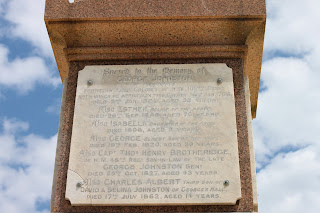 |
| Top of the Johnston Crypt |
Esther Abrahams was a 16 year old girl in England who was convicted of stealing fifty shillings worth of black lace in 1786 and was sentenced to seven years transportation for her crime. This was at the time when England was sending their convicts off to their Australian colony. Abrahams was sent as a convict on the first fleet to arrive in Sydney. She arrived in 1788 with her daughter, born to her out of wedlock, on the Lady Penrhyn. While on board the ship Esther was able to make acquaintances with First Lieutenant George Johnston. This would prove to be the turning point in Abrahams life. Not only was she able to have a more pleasant experience on the voyage to Australia, but upon arrival Johnston made Abrahams his de facto wife, not seen as legal by the law but they believed that they were married, together they had seven children. In 1808, George Johnson was involved in the overthrowing of the Governor Bligh of New South Wales, which in turn made him the new Governor of the State and Esther would be the unofficial first lady. It was not until 1814 that the two were officially married. Abrahams lost her husband in 1823, but was left quite a bit of land which made her a very wealthy land owner.
 After her husband's death Esther was faced with challenges from her own children, particularly her son Robert, whom she lived with for five years after the death along with two of her daughters. Robert decided to have his mother declared insane. He wanted this to happen so that he would be able to inherit the land before her death. However even though the courts declared her to be insane, Robert was not allowed his inheritance until his mother died in 1846, which was the way his father had laid out the inheritance policy. It would not be until Esther's great-great-great grandson that the family would see another person take the position of Governor of the state.
After her husband's death Esther was faced with challenges from her own children, particularly her son Robert, whom she lived with for five years after the death along with two of her daughters. Robert decided to have his mother declared insane. He wanted this to happen so that he would be able to inherit the land before her death. However even though the courts declared her to be insane, Robert was not allowed his inheritance until his mother died in 1846, which was the way his father had laid out the inheritance policy. It would not be until Esther's great-great-great grandson that the family would see another person take the position of Governor of the state.This may seem like another story of woman meets man in power and her life is changed for ever, and in the simplest of forms it may be. However I believe that the story of Esther Abrahams is one that shows how even though she was a convict, she was able to break the mold that she thought she was going to live when she began her voyage to Australia. By being able to go and visit her crypt which also houses her husband and other family members it allows people to see that changing ones life is possible and that Esther Abrahams is a prime example of this.
 There is also another reason why I chose to go out to the Waverley Cemetery. I was informed by friends that there are rumors of them moving the graves of the dead so that the land can be developed. This cemetery also has some of the most amazing views of the open ocean, as it sits between Coogee and Bronte beaches. Whether it is true or not it is something that should not even be open for discussion. This cemetery houses so many people and family histories, and as proven above is a link to some of the first colonizing citizens of Australia. I would highly recommend the visit out to Waverley Cemetery to not only see Esther's crypt but to also explore and have a chance to take in a gorgeous view.
There is also another reason why I chose to go out to the Waverley Cemetery. I was informed by friends that there are rumors of them moving the graves of the dead so that the land can be developed. This cemetery also has some of the most amazing views of the open ocean, as it sits between Coogee and Bronte beaches. Whether it is true or not it is something that should not even be open for discussion. This cemetery houses so many people and family histories, and as proven above is a link to some of the first colonizing citizens of Australia. I would highly recommend the visit out to Waverley Cemetery to not only see Esther's crypt but to also explore and have a chance to take in a gorgeous view.Information Provided from: http://www.smh.com.au/articles/2003/07/25/1059084203068.html and http://www.dictionaryofsydney.org/entry/abrahams_esther
Pictures were taken by myself on October 30, 2011







